Research Journal of Applied Sciences, Engineering and Technology
Physical and Chemical Characteristics of Rice Straw
Research Journal of Applied Sciences, Engineering and Technology 2020 17: 115-121
Cite This ArticleAbstract
This study aims to determine the physical characteristics of rice straw and highlights the presence of sugar in rice straw.The use of natural fibers as a reinforcement in construction has existed for millennia. They are mixed with clay to make building materials. This addition avoids cracks and sometimes contributes to flexural strength. Researchers have detected a high level of sugar in natural fibers. This sugar contained in the biomass is at the origin of the setting delay and the hardening of the building materials. Another not least significant defect found in natural fiber is its high water absorption potential. This hydrophilic character is due to the intrinsic porosity of the straws.This article aims to determine the physical characteristics of rice straw and highlights the presence of sugar in rice straw. First, the density and water absorption rate of the rice straw were determined. Then chemical tests were carried out to determine the rate of mineral constituents (ash), lignin, hemicellulose and finally the rate of cellulose is deduced. Like most crop straws, rice straw contains a high level of sugar. It also has a very low density compared to other building materials. It is around 450 kg/m3. Rice straw also has a high water absorption rate. The absorption rate absorption rate (At) 5 min of immersion in water, its absorption rate reaches 234%.
Keywords:
Introduction
The improvement of the mechanical characteristics of the earth by the reinforcement in natural fiber, the incorporation of horsehair or agricultural waste has been used for several decades (Mahamat et al., 2015). However, industrialization and scientific research on composite materials reinforced with vegetable fibers for their recovery in buildings is recent. They date from the 1970s, where asbestos fibers were replaced by plant fibers in the prefabricated elements, and fiber cement profiles (cladding, tiles, plates, etc.) (Calvet et al., 1974). Since then, research in this area has spread to all continents for the proper mastery of characteristics. Developing countries have become much more interested in these plant fibers because of their availability and their low cost.
The use of plant fibers as a reinforcement for composite building materials has two advantages (Calvet et al., 1974). First, these fibers are widely available at low cost and their use in construction brings income to farmers. On the other hand, the allocation of plant fibers in construction allows the reduction of greenhouse gases in the environment compared to mineral binders (cement and lime). These vegetable fibers are renewable raw materials, biodegradable and neutral vis-à-vis CO2 emissions and they are not demanding in terms of gray energy for their production (Baley, 2013). These vegetable fibers are an alternative to synthetic fibers (metallic, mineral or polymeric fibers) in developing countries.
Raw fibers are, in contrast to processed fibers, obtained at low cost and using little energy through locally available labor and know-how (ACI 544.1996). A wide variety of vegetable fibers can be used depending on the resources available in each region.
Chad is endowed with important natural resources favorable to agriculture. Eighty-two percent of the population (total population: 15.400.000) lives in rural areas. The hydrographic network of Chad is very important and plays a driving role in the development of the country (Ministre de l’Agriculture et de l’Irrigation du Tchad, FAO, (2013). It also has significant groundwater resources: 263 to 455 billion m3 exploitable per year. Cereal cultivation is practiced in the Sahelian zone and the Sudanian zone because of the abundance of rain. All food crops generate a significant amount of straw. The straw-to-grain ratio is around 1.5: 1 (Calvet et al., 1974). Cultivated straw is intended for several uses including the construction of dwellings and animal parks, cooking food or heating in winter, and especially for the feeding of domestic animals in dry season. Rice is much more cultivated in the Sudanian zone and less in the Sahelian zone, because of its high demand for water (Ministre de l’Agriculture et de l’Irrigation du Tchad, FAO, (2013). Although rice ranks 5th in food crops. It is possible to increase its production given its industrialization. In this research work we determine the physical and chemical characteristics of rice straw in order to better understand its use as a building material.
Materials And Methods
In this part, we determine the density, the humidity and the chemical constituents of rice straws.
The rice straws: Rice cultivation is a priority for Chadians for its development. The residue from this crop finds its use in heating energy, in the construction of huts for farmers in the countryside and also constitutes food for animals (Fig. 1).
Physical characteristics: This paragraph is devoted to the methodology for measuring the density, moisture and chemical composition of the rice straw used.
Density of rice straw: For bio-based materials, such as rice straw, the density is determined indirectly according to standard (NF P94-064 1993). This standard applies to the determination of the dry density of a rock element, and we have adapted it to determine the density of rice straws. Given its absorbency, the studied sample is covered with paraffin oil to protect it from water penetration, (Fig. 2a).Then hydrostatic weighing are carried out to determine the density. The steps are described as follows. A sample of rice straw dried in an oven at 105°C for 24 h is weighed, then placed in a container (tare) and impregnated with paraffin oil. The paraffin-coated sample is weighed in the open air when its temperature has reached room temperature in the test room and then hydrostatic weighings are performed on the paraffin-coated sample (Fig. 2b).
The density calculation is determined as follows:
Sample mass:
$ m_s = m_{(t+s)} - m_t ~~~~~~~~~~~~~~~~~~~~~~~~~~~~~~~ (1)$
Paraffin mass:
$ m_p = m_{(s+p)} - m_s ~~~~~~~~~~~~~~~~~~~~~~~~~~~~~~ (2)$
Paraffin volume:
$ V_p = \frac{m_p}{\rho_p} ~~~~~~~~~~~~~~~~~~~~~~~~~~~~~~~~~~~~~~~~~~~~~~ (3)$
Total mass:
$ m_t = m_{(s+p)} - m_{(s+p)}^\prime ~~~~~~~~~~~~~~~~~~~~~~~~ (4)$
Total volume:
$ V_t = \frac{m_t}{\rho_w} ~~~~~~~~~~~~~~~~~~~~~~~~~~~~~~~~~~~~~~~~~~~~~~~ (5)$
Sample volume:
$ V_s = V_t - V_p ~~~~~~~~~~~~~~~~~~~~~~~~~~~~~~~~~~~~~~ (6)$
The density of the sample:
$ \rho_s = \frac{m_s}{V_s} ~~~~~~~~~~~~~~~~~~~~~~~~~~~~~~~~~~~~~~~~~~~~~ (7)$
From the geotechnical formula the total porosity (η) is determined by Eq.(8):
$ \eta(\%) = 100(1 - \frac{\rho_s}{\rho_a}) ~~~~~~~~~~~~~~~~~~~~~~~~~~ (8)$
Water absorption: Bio-based materials have a very high absorbency. This hydrophilic nature is due to the presence of polysaccharide molecules (hemicellulose and cellulose) which have an ability to fix water molecules. For its use as an aggregate, it is necessary to understand its water absorption capacity and its absorption kinetics in order to propose solutions.
To do this, we took 35 g of rice straw, dried in an oven at 105°C for 2 days to obtain dry aggregates. This temperature is often used with wood to achieve complete evaporation of water (Nguyen et al., 2009).
The oven-dried particles are immersed in water with residence times from 5 min to 48 h. The absorption rates of rice straw A(t) is determined by:
$ A\left(t\right) = 100\left(\ \frac{m_t-m_o}{m_o}\right) ~~~~~~~~~~~~~~~~~~~~~~~ (9)$
Analysis of chemical composition: Plant biomass is made up of three polymers. These are cellulose, hemicellulose and lignin. In addition to these three polymers, there are also extractable substances and mineral substances (ash) which are quantified by incineration of wood at high temperature (500 to 600°C) for 24 to 48 h (Mounguengui, 2008). In general, the cellulose level represents 40 and 45% in hardwoods and conifers. For hemicellulose, its rate is 25 to 30% for hardwoods and 30 to 35% for softwoods. The lignin level varies from 15 to 25% in hardwoods and 25 to 30% in softwoods. For extractable substances, the rate is 2 to 5% for softwood, 3 to 8% for temperate zone wood and up to 18 to 22% for tropical wood (Huang et al., 2009). Mineral matter, on the other hand, rarely exceeds 1% in temperate zone species and can reach rates of up to 2% for tropical woods (Fengel and Wegener, 1989), cited by Mounguengui (2008). The presence of water-soluble in lignocellulosic fibers modifies the hydration reaction of the cement and causes delays in setting and hardening of the mixture (Merzoud, 2007). The presence of polysaccharides in the composite affects the hydration of the cement and the hydration delay depends on the type of cement (Peschard et al., 2004). The pre-wetting time of natural fibers increases the strength and workability of the composite (Lo et al., 1999). Boiling the diss fibers completely destroys the sugars in the lignocellulosic fibers and provides the composite with hydration and hardening comparable to ordinary mortar (Merzoud, 2007). In this research study, we will highlight the presence of sugar in rice straw and propose a solution for its use in construction.
Ash rate: By definition, the ash content αA is the ratio between the mass of mineral salts of a biomass on the anhydrous mass of said biomass:
$ \alpha_A = 100\ (\frac{m_A}{m_o}) ~~~~~~~~~~~~~~~~~~~~~~~~~~~~~~~ (10)$
The determination of this content is relatively easy: a sample of biomass of known anhydrous mass is placed in a ceramic crucible. The crucible is then deposited in an oven supplied with air (Fig. 3). The sample is gradually heated to a temperature of 600°C. All the organic matter is consumed and, when the combustion is completely finished, all that remains is the mineral matter in the crucible whose mass is measured after having returned the crucible to ambient temperature.
Extractable: Extractable are organic substances with low molecular weights. They are found in the porous structure of wood. They are called extractable because these substances are soluble in the various organic solvents (hexane, dichloromethane, acetone, toluene, ethanol, methanol ...) or in water. Different methods are used to determine the extractable substances found in the biomass. This is the hot method using a Soxhlet or an accelerated Dionex extraction system, maceration or steam distillation. For our research study, we used the hot extraction method using a Soxhlet and acetone is used as a solvent. The determination procedure is described as follows: We take a sample of crushed and straw-dried rice straw in an oven for 24 h at 105°C. The sample is placed in a glucose cartridge and then placed in the Soxhlet reservoir. The flask is filled to three-quarters of its volume of acetone (solvent) and is heated to boiling. The acetone rises by evaporation to the cooler. It is condensed and falls back into the Soxhlet tank in liquid form to dissolve the extractable. Once the tank is filled, the solvent and extractable fall into the flask. The same cycle is repeated until the contents of the tankbecome clear. The acetone is collected in the acetone bin and the cartridge is dried in an oven at 105°C for 24 h and weighed. Figure 4a and 4b show the start and end of the extraction test, respectively.
The characterization of extractives in our rice straw is performed using a common method derived from the one proposed by the NREL (Sluiter et al., 2012). We have used acetone as a solvent and a Soxhlet extractor device. The extraction was realized on about 20 g of oven dry powder and repeated twice a check the reproducibility of the analysis:
$ \alpha_E = 100(\frac{m_E}{m_o}) ~~~~~~~~~~~~~~~~~~~~~~~~~~~~~~~~ (11)$
Lignin organosolv: A rice straw sample is ground for the determination of organosolv lignin. A mass of 15.16 g of rice straw, dried in an oven at 105°C for 24 h is treated in a 760 mL batch reactor according to a protocol is described below:
- The reaction mixture is prepared as follows: 78.832 mL of ethanol + 42.448 mL of distilled water + 159.18 µL of 4N sulfuric acid.
- The mixture is heated in a batch reactor at a temperature of 170°C for 1 h, then this mixture is cooled to a temperature below 30°C in <3 min (use of an internal cooling coil + external cooling), (Fig. 5a).
- Once cooled, the product is filtered with the rinsing of the solid with 3×25 mL of a mixture of water and ethanol which has the same composition as the initial phase. The temperature of the washing liquid is 60°C. This operation makes it possible to recover a solid product on a filter paper and the liquid part containing the organosolv lignin in a beaker.
- Three volumes of distilled water are added to the liquid products which precipitates the organosolvlignins. This results in centrifugation for 30 min (Fig. 5b).
- The solid deposit is recovered by filtration, dried in an oven at 40°C for 2 days, and then weighed. It's organosolv lignin.
Klason lignin: After the organosolv lignin extraction test, the solid recovered by filtration is ground and sieved, then its Klasonlignin level is determined (Fig. 6). The experimental protocol is as follows:
- One hundred and seventy-five milligram of powdered rice straw are mixed with 1.5 mL of 72% concentrated sulfuric acid.
- The mixture is placed in a thermostatically controlled bath, stirred at 30°C for 1 h.
- Forty-two milliliter of distilled water is added to the mixture which is placed in an oven at 121°C for 1 h. The product is filtered, and the solid dried in an oven for 24 h at 105°C and then weighed. It’s Klason’s lignin. During these different characterization operations, the missing part represents the hemicellulose which has precipitated.
The cellulose content is obtained by the following formula:
$ \alpha_c\left(\%\right) = 100-\alpha_H(\%)-\alpha_L(\%)-\alpha_A(\%)-\alpha_E(\%) ~~~~~~~~~~~~~~~~~~~~~~~~~~ (12)$
Determination of simple sugar level: The carbohydrates composition is also characterized according to a standardized method of the NREL presented in one of their technical reports (Sluiter et al., 2012). We will not present the sugars contents but the proportion of some simple sugars that have been identified by ionic chromatography using a pulsed amperometric detector.
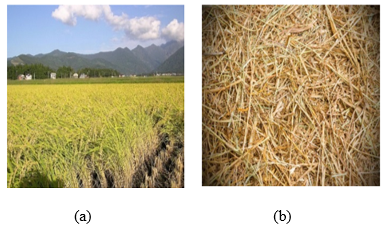
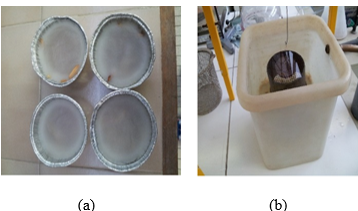
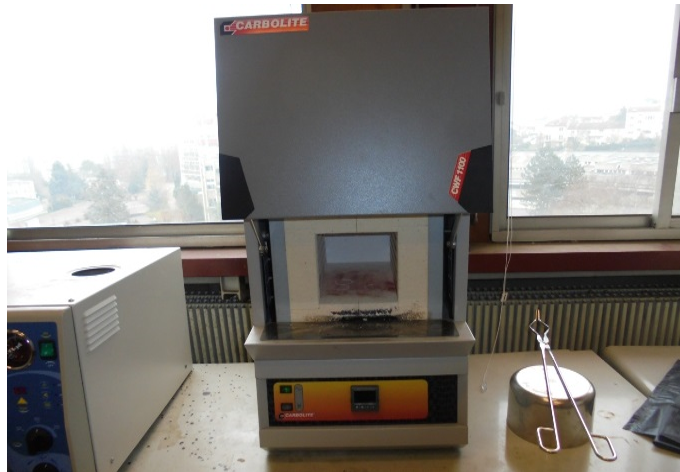
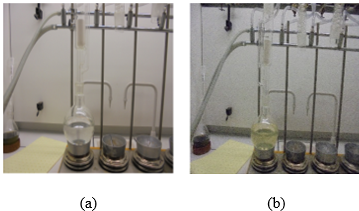
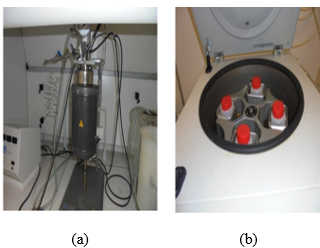
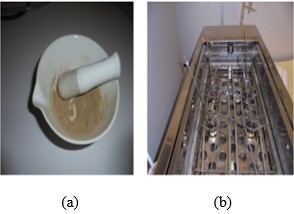
Results And Discussion
Physical analysis: The density values of rice straw are presented in Table 1.
The density values of our rice straw are naturally low, especially compared to those of other building materials. The low density of the latter is due to the intrinsic and apparent high porosity of rice straw, which is of the order of 93.5%.
With its low density, the use of rice straw in the construction helps to lighten the structure. This saves on the formwork and the reinforcement of the elements of the structure. We can also think that these straws can be used as thermal insulation for the realization of building materials.
The absorption rate of the straw is very high. After 5 min immersion in water, the absorption rate is 206% (Fig. 7). This final absorption rate is of the same order of magnitude as the results obtained by Nguyen et al., 2009 on the chenevotte particles.
The hydrophilic behavior of the culture straw is due to their high porosity (93%). For the realization of building materials, it is imperative to pre-humidify the straw until saturation before introducing it into the mixture (straw, clay and binder). Without pre-moistening, the rice straw in the dry state would absorb all the mixing water and therefore the cementitious composite would lack water for its hydration.
Physical characteristics such as density and absorption rate are determined. As for the density of rice straw, it is very low. This low value is due to the intrinsic porosity of the straw. With a low density, the use of rice straw in construction lightens the structure. This saves on formwork and reinforcement of structural elements. The absorption rate of the straw is too high. During 5 min of immersion in water, the absorption rate is 206%. At 48 h of immersion, it reaches 348%.
This final absorption rate is in the same order of magnitude as the results obtained by Nguyen et al., 2009 on honeysuckle particles, which is 406% during two days of immersion. The hydrophilic behavior of crop straws is due to their high porosity. The total porosity of rice straws is estimated at 93%. The work of Nguyen et al., 2009 also confirmed the high rate of porosities on the particles of chénvottes where he found 92% of total porosity. It is imperative to prehumidify the straw until saturation before introducing it into the mixture, otherwise, the rice straw in the dry state would absorb all the mixing water and therefore the cement composite lacked water. Water for its hydration.
Analysis of chemical composition: The results of chemical analyzes are shown in Table 2.
In general, it is the polysaccharide compounds (cellulose + hemicelluloses) which are responsible for the adsorption of water. On average, the cellulose and hemicellulose contents are respectively 37.42 and 24.4%. These values are comparable to the results obtained by Sun and Cheng 2002 on crop straws (Sun and Cheng 2002).
We first note that the ash content of our straw is particularly high, compared to the ash content of biomass used in construction. These high ash levels indicate that it is not possible to envisage energy recovery from rice straws (by combustion and gasification, for example). One can only consider a valorization in the construction or an anaerobic digestion. This is the reason why, given the housing needs of the Chadian people. Material recovery in the field of construction seems to us the most relevant.
The chemical characteristics of rice straw showed the presence of sugars (glucose and xylose) in large quantities (Table 3).
The production of biomass/cement composites is often problematic because the presence of sugar causes delays in setting and hardening (Garci Juenger and Jennings 2002; Bilba et al., 2003). The solutions proposed by these authors focused on the physical and chemical treatments of plant aggregates. We use the treatment method proposed by Lo et al., 1999 for this research work. It is based on the pre-wetting of the fibers for at least 5 h.
Chemical tests have detected sugar in rice straw. They are around 37.42% cellulose and 24.4% hemicellulose. These values are in the same orders of magnitude as crop straw, which vary from 30 to 43% for cellulose and from 22 to 35% for hemicellulose (Sun and Cheng 2002). All the bibliographic literatures related to the valorization of the biomass in the various fields are unanimous on the existence of sugar in the latter. This sugar is a problem in the food composite, in particular the delay in setting and hardening of the materials. The artcles (Garci Juenger and Jennings 2002; Bilba et al., 2003) have shown that sugar delays the hydration of cement. The solutions proposed are focused on the physical and chemical treatments of plant aggregates.
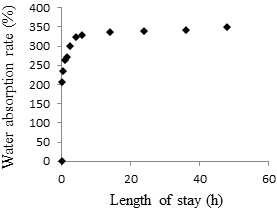
| Testing | 1 | 2 | 3 | 4 |
|---|---|---|---|---|
| $ρ_s(kg/m^3)$ | 462 | 460 | 465 | 469 |
| $ρ_A(kg/m^3)$ | 30 | 30 | 30 | 30 |
| $\alpha_E(\%)$ extractable |
$\alpha_A(\%)$ ash |
$\alpha_L(\%)$ lignin |
$\alpha_H(\%)$ holocelluloses |
|---|---|---|---|
| 2 | 17.56 | 18.63 | 61.81 |
| Arabinose (%) | 2.110 |
| Galactose (%) | 0.730 |
| Glucose (%) | 74.130 |
| Xylose (%) | 22.830 |
| Galacturonic acid | 0.108 |
| Glucuronic acid | 0.092 |
Conclusion
Like other lignocellulosic fibers, rice straw has a very low density, due to its high intrinsic porosity. The low value of the density of the straw makes it possible to save formwork and reinforcement of the infrastructures.Rice straw also has a water absorption rate of up to 348% of its mass. For its use as a building material, it should first be pre-moistened in water. Chemical characteristics on rice straws detected simple sugar. The latter is the cause of delay setting and hardening composites. The proposed solution is the extended pre-wetting of rice straws in water. This solution will solve the problem of absorption of rice straw and at the same time considerably reduce the sugar content in the latter. In the rest of our research, we value rice straw in construction.
Acknowledgement
We thank all the managers and colleagues of the laboratories where we carried out our work, may they find here our deepest gratitude.It’s about:
- The Energy and Material Laboratory (LEM), INSTA, Chad
- The Laboratory for Study and Research on Wood Material (LERMAB), Faculty of Sciences and Technology (F.S.T), University of Lorraine University, France
- The Laboratory of Buildings and Public Works (LBTP) N’Djamena Chad.
Author Details
1Département de Génie Civil, Ecole Nationale Supérieure des Travaux Publics (ENSTP), N’Djamena, Tchad
2Département de Génie Energétique, Institut National Supérieur des Sciences et Techniques d’Abéché (INSTA), BP 130, Abéché, Tchad
3Faculté des Sciences et Technologies, Laboratoire d’Etudes et de Recherches sur les Matériaux Bois (LERMAB), Université de Lorraine, Campus Aiguillettes - BP 70239-54506 Vandœuvre-lès-Nancy, France
Nomenclature
$ \begin{aligned} A_(t) & : \text { Absorption rate (%) } \\ m_A & : \text { Ash mass (kg) } \\ m_E & : \text { Mass of extractable (kg) } \\ m_o & : \text { Anhydrous mass of rice straw (kg) } \\ m_p & : \text { Mass of paraffin coated sample (kg) } \\ m_p’ & : \text { Mass of the sample coated with paraffin and weighed in water (kg) } \\ ms & : \text { Mass of dry sample (kg) } \\ mt & : \text { Anhydrous mass of rice straw at instant t (kg) } \\ V_p & : \text { Volume of paraffin coating the rice straw sample } (m^3) \\ V_s & : \text { Volume of sample } (m^3) \\ V_t & : \text { Volume total } (m^3) \\ \alpha_A & : \text { Ash rate (%) } \\ \alpha_E & : \text { Extractable rate (%) } \\ \alpha_H & : \text { Holocellulose rate (%) } \\ \alpha_L & : \text { Lignin content (%) } \\ \eta & : \text { Apparent porosity of the straw (%) } \\ \rho_A & : \text { Apparent density of rice straw } (kg/m^3) \\ \rho_S & : \text { Density of rice straw } (kg/m^3) \\ \rho_w & : \text { Density of water } (kg/m^3) \end{aligned} $
References
Rights and permissions
Open Access: This article is licensed under a Creative Commons Attribution 4.0 International License, which permits use, sharing, adaptation, distribution and reproduction in any medium or format, as long as you give appropriate credit to the original author(s) and the source, provide a link to the Creative Commons license, and indicate if changes were made. The images or other third-party material in this article are included in the article’s Creative Commons license, unless indicated otherwise in a credit line to the material. If material is not included in the article’s Creative Commons license and your intended use is not permitted by statutory regulation or exceeds the permitted use, you will need to obtain permission directly from the copyright holder. To view a copy of this license, visit http://creativecommons.org/licenses/by/4.0/
Cite this Article
DOI: http://doi.org/10.19026/rjaset.17.5478
Sections